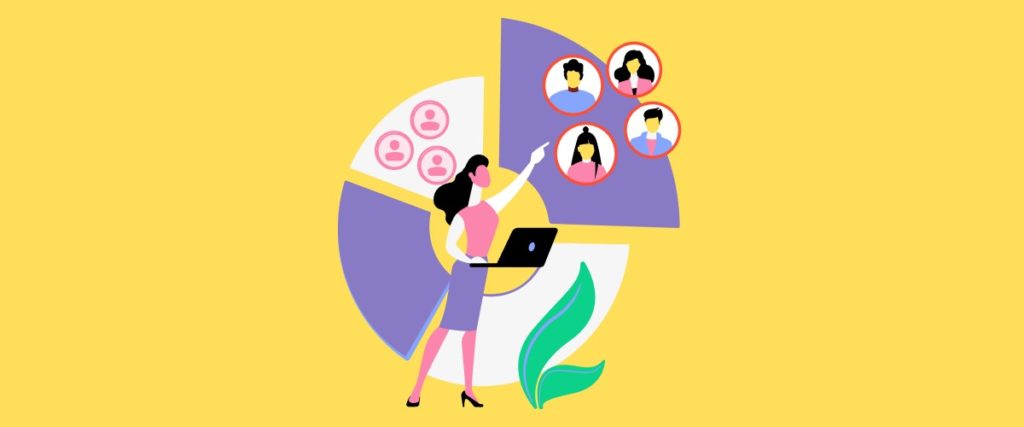Demographic segmentation is a customer segmentation strategy that groups people based on their location, gender, age, income, and other tangible characteristics.
Though it’s usually the first step marketers take to understand their audience better, it’s not the only one, as you’ll learn in this guide.
To optimize your marketing spend, demographic segmentation should be used in conjunction with both psychographic segmentation, behavioral segmentation, and customer purchase intention.
In this guide, we’ll define demographic segmentation, cover how to use it in eCommerce, and show you some demographic segmentation examples.
We’ll also show you why market segmentation is worth the effort and discuss some limitations to consider (along with how to overcome them).
What Is Demographic Segmentation?
Demographic Segmentation Vs. Behavioral and Psychographic Segmentation
How to Use Demographic Segmentation
How to Find Your Target Customers Demographics
Benefits of Demographic Segmentation
Limitations of Demographic Segmentation
6 Types of Demographic Segmentation + Examples
Final Thoughts on Demographic Segmentation
What Is Demographic Segmentation?
Demographic segmentation is a customer segmentation strategy that groups people based on their location, gender, age, income, and other tangible characteristics.
To unpack that demographic segmentation definition, you first have to know what demographics are.
Demographics are statistical characteristics of a group of people. In this case, that group is your potential and existing customers.
Demographics provide intel about your target customers’ gender, age, income, education level, marital status, employment/occupation, family status, and more. Knowing these facts helps paint a well-rounded picture of your customer base.
If you’ve ever created customer personas for your brand, you’ve used demographic segmentation firsthand.
Demographic Segmentation Vs. Behavioral and Psychographic Segmentation
All three customer segmentation strategies should be used together to create an effective marketing strategy that drives customers to your product or service, quickly converts them, and keeps them hungry for more.
There are three main ways to tackle eCommerce segmentation:

- Demographic segmentation: Dividing your target audience based on demographics such as location, gender, age, income, occupation, and other defining data.
- Psychographic segmentation: Grouping people based on psychological traits, such as their goals, beliefs, interests, likes/dislikes, and lifestyles.
- Behavioral segmentation: Categorizing people by the actions they take, such as whether they’re a new or returning customer and how they interact with your brand.
A solid marketing strategy focuses on all three customer segmentation strategies. This gives you and your team a holistic overview of your target audience, including where they come from, what they’re looking for, and how they engage with your product/service.
That’s why you should look at these segmentation strategies like a funnel.
Demographic segmentation is typically the widest part of the funnel. This basic level of segmentation starts to establish a general overview of who you’re trying to target.
In our makeup example, this would be like targeting women within certain age ranges.
As you move deeper and lower down your funnel, you get to psychographic segmentation. This further divides your target audience by what they’re hoping to achieve or solve with your product/service.
In the makeup scenario, grouping women by their goals is an example of psychographic segmentation. You may have:
- Women trying to erase fine lines and wrinkles
- Girls hoping for clearer skin
- Those who just want to be ahead of trends.
That’s three separate psychographic subdivisions.
Behavioral segmentation is the narrowest part of your funnel, where you’ll further divide the subcategories you uncover based on the actions they take.Going back to makeup, you may observe through clickstream and other data that some customers abandon their carts, and others are loyal customers and brand advocates.

This is a perfect example of how you can use all three segmentation strategies to create more effective marketing campaigns that drive your ideal customers towards your brand and convert them.
So now that you understand the differences between each segmentation strategy and how they work synergistically with each other, let’s dive into how to use customer demographics in your eCommerce strategy.
How to Use Demographic Segmentation
Demographic segmentation should be used as a first step to understanding and grouping your customers so you can then get more granular in your segmentation under each group.
If you’re marketing for a makeup brand, here’s what that might look like.
Gender: Women
Age groupings: Teens (13-18), Young Adults (19-29), Adults (30-55)
Geographical area: Southeastern US, Northern US, Southwestern US
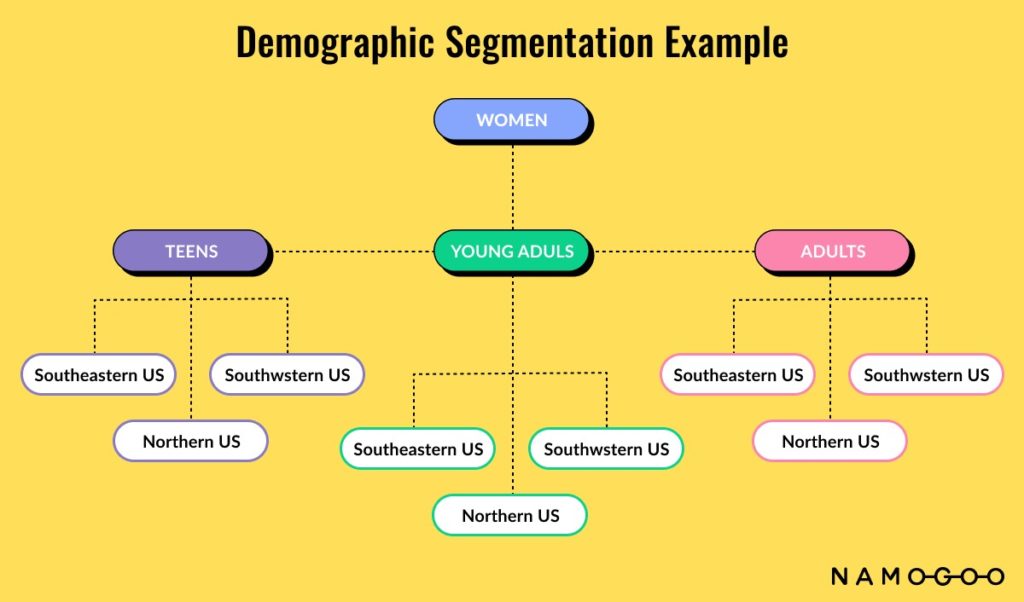
For example, you might target teens, young adults and college-aged women, and older adults. If you were to target all groups generically messages, you may struggle to convert. You’ll also waste valuable time and money.
Demographic segmentation helps to inform the psychographics and provide context behind the behaviors of your customers. This enables you and your team to craft more effective messages that speak directly to each subcategory and the specific pain points they’re trying to solve.
Following this strategy and example, you may learn that your customer base wants different things out of their makeup products. Teens may want to cover up acne, college students (young adult group) may want more coverage to hide sleepless nights, while older women may prefer lighter foundations with more sun protection (adult group).
Now you can create two different messages that better resonate with what each segment of your audience is looking for — and actually convert both groups simultaneously.
How to Find Your Target Customers Demographics
Where you gather data for demographic segmentation matters. If you’re using your best guesstimate and assuming you know the perfect fit for your product, you’ll be doing a major disservice to your brand.
While you may have a pretty good idea of who can use your product, it’s always best to dive into the actual data to see who’s really buying and benefiting from it.
To do this, check out key data points from your:
- Highest-spending customers
- Top returning customers
- Analytics software (to see who’s going to your website and converting)
- Customer surveys (to hear what people actually think)
- Social media mentions
- Email campaign metrics
This actual intel will provide a better idea of your true demographics, which is what you should be using to base your decisions on (as opposed to your unquantified beliefs or theories).
We’ll show you how to create messages that hit home later. For now, let’s discuss the differences between demographic segmentation and the other types of segmentation strategies.
Benefits of Demographic Segmentation
Demographic segmentation is definitely worth your time, but you may face a few challenges when following this strategy. These are the most common upsides and downsides:
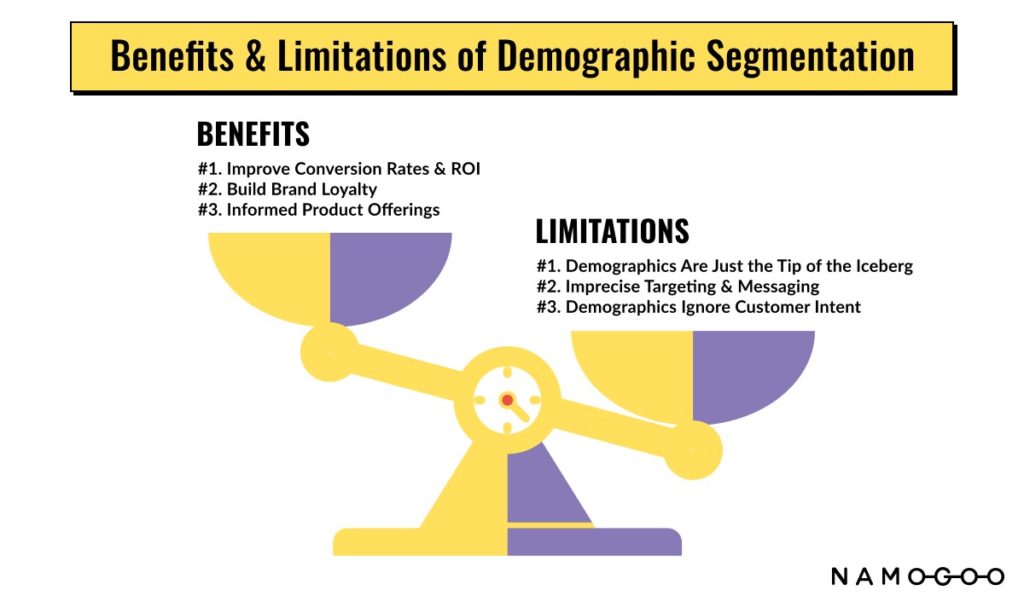
#1. Higher Conversion Rates & ROI
Segmenting your audience by demographics allows you to run better marketing campaigns that save money while increasing conversions.
Rather than throwing money at messages that don’t connect with anyone or wasting time on audiences least likely to convert, you can save your resources for those that will.
Creating highly targeted marketing messages based on your demographic data will help you address specific pain points different customer groups are looking to solve.
You’ll build trust, understanding, and authority across your customer base. They’ll quickly see your brand has the solution they’ve been searching for, and they’ll want to act on it fast.
Resonating with your target audience and proving you’re the right choice will naturally increase your conversion rates and sales, giving you a more impressive ROI for not much more effort.
#2. Build Brand Loyalty & Strengthen Your Customer Relationships
Understanding your customers on a deeper level allows you to build better relationships with them. You’ll be able to uncover what they’re really struggling with and help them see a solution to their problems with your help.
Over time, this will naturally build brand loyalty and encourage brand ambassadors. Your customers will think of your brand as their go-to anytime they need a similar problem fixed. You’ll stay top of mind, and there won’t be any question of where to turn for their next product.
Further, your happy customers will be eager to share their newfound problem-solver (i.e., your brand) to help their friends, family, coworkers, etc. dealing with similar issues. You’ll be increasing your brand awareness and reach without spending a dime to do so.
#3. Informed Product Offerings
A deeper understanding of your target audience allows you to improve your product or service or create new ones that specifically cater to solving your customers’ biggest pain points.
Because you’ll know your target audience inside and out, you won’t waste time or money on research and development. You’ll know exactly what to create next and which features to add to keep your existing customers happy and capture new ones.
But you won’t be able to reap these benefits if you don’t segment your customers to figure out what they’re going through first.
Limitations of Demographic Segmentation
#1. Demographic Segmentation is Only the First Step
As mentioned earlier, demographic segmentation should be your first step, but this solid foundation is just the beginning. Even though you may improve key performance metrics (KPIs) with this strategy, don’t be tempted to stop here.
It’s crucial to divide your audience further using psychographic segmentation and behavioral segmentation. These will help you guide customers along your sales funnel, optimize your marketing spend, and create lifelong buyers. You’ll be able to predict what customers need and know precisely how to deliver.
Sure, incorporating all three segmentation strategies may take a bit of extra legwork. But only choosing one will cause your brand to miss out on key sales and conversions, which is why it’s definitely not recommended.
#2. Imprecise Targeting & Messaging
Relying only on demographics in your customer segmentation strategy will lead to imprecise targeting and messaging.
Returning to that makeup example mentioned earlier, if you’re setting up a campaign in Facebook and you target audiences based only on demographics (let’s say women between the ages of 20-45), you’ll run into the issue we already discussed: not targeting your audiences and messaging leads to creating generic ones that don’t resonate with anyone.
So you’ll need to make sure that you don’t stop at surface-level demographics and instead go as deep as you can, which could mean further dividing your demographics into smaller subcategories based on other segmentation strategies.
How far should you go?
Psychographic segmentation and behavioral segmentation are a must after demographics. But you could also decide to try geographic segmentation, which targets customers based on where they live. Maybe women in warmer climates need makeup that outlasts humidity, for example, whereas those living in high altitudes need skincare with extra moisture.
You could spend your entire day diving down a rabbit hole of customer data to uncover gems like these that move KPIs in your favor. But it’s always better to know more about your customers than not enough. Your metrics may clue you into the perfect middle ground.
#3. Demographics Ignore Customer Intent
While grouping customers based on their demographics is a cornerstone of any segmentation strategy, stopping there ignores the most important conversion factor:
Intent.
Understanding customer intent — and how to measure and use it — is one of the most powerful ways to influence online consumer behavior.
Google cites that “marketers who try to reach their audience solely on demographics risk missing more than 70% of potential mobile shoppers”[*].
It uses the example that 40% of those who purchase baby products live in households without children.
Read More: Customer Purchase Intention: Definition, Why (+ How) to Measure & Convert
Focusing on demographics would lead you to ignore those high-intent potential customers in favor of only those who meet the demographics of new parents.
A solid eCommerce strategy encompasses the spectrum of segmentation, from demographics to customer behaviors and tops it off with intent.
6 Types of Demographic Segmentation + Examples
If you’re wondering how to segment your audience by demographics, these six demographic segmentation examples will give you a stellar foundation.
You may not segment your audience using all of these divisions, but they’ll quickly help you whittle down your customer base, so you can move onto psychographic and behavioral segmentation next.
1. Segmenting by Gender
One of the easiest and best ways to start segmenting your audience is by gender.
If your product is already geared towards men or women specifically, starting with this first segmentation won’t take long. However, you’ll need to do a bit of sleuthing if you sell unisex products or a service that doesn’t differentiate between genders.
Here are some examples of what it looks like to segment by gender:

Manly Bands, a wedding band company for guys, does an exceptional job targeting for their gender (pictured above). The brand’s most popular “manly styles” include wedding bands named after alter-egos like “the rockstar,” “the cowboy,” and “the gentleman.”
On the other hand, Blush & Bar, a women’s jewelry brand (pictured below), clearly targets the opposite gender. Pops of light pink and female-centric hashtags are sprinkled throughout the website to attract their target audience:

Though gender is often the first step in demographic segmentation, you know you shouldn’t stop here. Remember the makeup example with the young and older women? Same gender, two different needs.
Additionally, to many millennials and Gen Z customers especially, gender expression is a fluid notion that can change over time and according to their moods.
That’s why you should strongly consider further segmenting by age, life stage, income, family status, and any of the other categories we’re about to share.
2. Segmenting by Age
The next way to segment your audience by demographics is to consider their ages. You won’t know whether your product or service resonates with one age range or a few different ones until you start segmenting.
You’ll also likely find striking differences between each subgroup’s needs once you break things down by birthdates. That’s why it’s so vital to consider this segmentation higher on the list of priorities than some of the others.
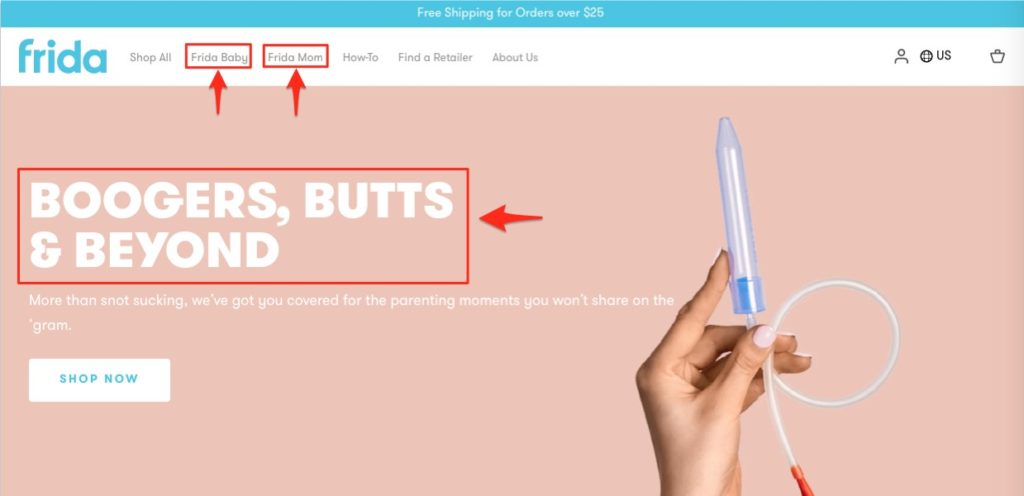
Frida, a popular parenting brand (pictured above), does this well by offering products for babies and moms alike. You can see their two distinct sections for baby products and Frida moms.
These separate pages allow Frida to send targeted ads directly to browsers of each section, which increases their conversion rates. And since babies aren’t browsing the site, their mom-friendly messages and copy resonate perfectly with their target audience.
3. Segmenting by Geographical Location
Many segmentation models separate geographical location from demographics, considering physical location its own model.
For the purposes of eCommerce, it’s best to instead treat it as another demographic type.
You can group customers based on:
- Continents
- Countries
- States or provinces
- Cities or towns
- Zip or postal codes
- General areas (the Midwest, for example).
In our cosmetics brand example, you might group customers geographically to target dryer areas with a hydrating foundation, or coastal cities and islands with waterproof foundation.
4. Segmenting by Life Stage
It’s always wise to consider the different life stages your customers may be in or going through.
Have they recently graduated college, started a family, become empty nesters, or retired?
Since these life stages are incredibly different, they require unique messages to address your customers’ individual pain points.

You can see how baby and kids brand Buy Buy Baby targets parents with children in multiple life stages all in one place (pictured above). They show product options from newborn to toddler on the same page, proving you can go after multiple demographic segments when done correctly.
5. Segmenting by Family Makeup
On top of life stages, you may also want to consider using family makeup as another segmentation strategy.
While they sound similar, family makeup is actually different from life stages. The makeup focuses on the size of the family, whereas the latter concentrates on where they’re at in life.
For example, are you targeting single people, married couples without kids, or parents with multiple children? Single people may have more income to spend on themselves, but parents of multiple kids are always on the hunt for discounts.
You should know these subtle differences to better structure your messages and prove you understand your customers’ specific needs.
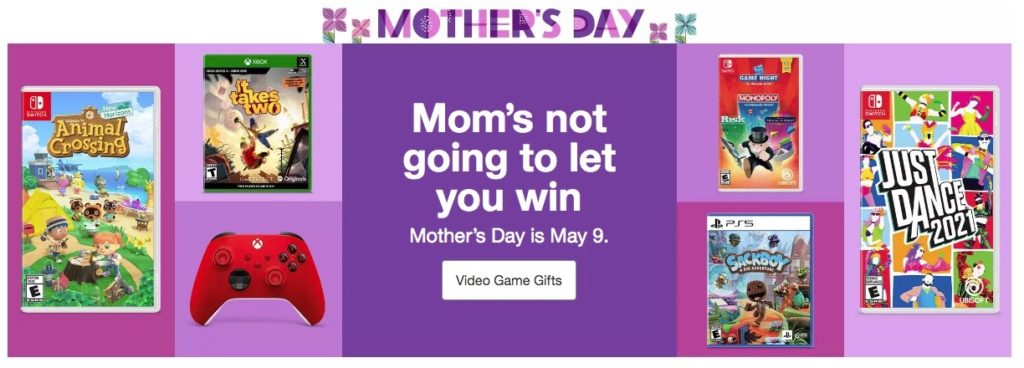
Target thought it was smart to subtly nudge parents and kids of all ages looking for video games to consider buying one as a gift for Mother’s Day (pictured above). This tactic helps them knock out two birds with one stone (snagging a new video game and giving Mom a gift that ensures quality fun time).
6. Segmenting by Income
You must consider your potential customers’ income levels during segmentation. After all, you’ll only waste your time and money marketing to customers who may not have the salary to afford your products or service.
Once you have a better idea of their budgets, you can adjust accordingly.
For example, high-end customers may demand more sophisticated or targeted messages to show why your brand stands out from the others vying for their disposable income.
Similarly, a budget-conscious consumer may need more prodding to splurge on your luxury or premium products.
And advertising discounts to those with less money to spend shouldn’t come across as your brand selling cheap or low-quality products. You’ll need to focus your messaging on value for the price.
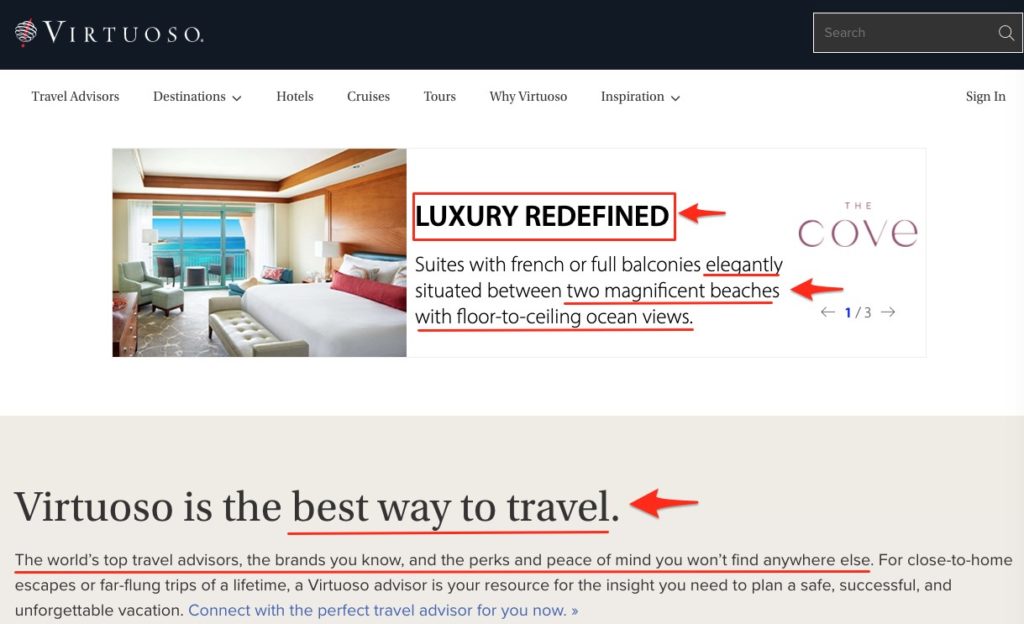
Here’s an example from Virtuoso, a luxury travel agency (pictured above), which targets high-end customers looking for an unforgettable vacation. They use words like “elegant,” “magnificent,” and the “best way to travel” to show they’re on the same page as their posh travelers.
7. Segmenting by Occupation
Along the lines of income, you may also want to think about what your customers do for a living when segmenting by demographics.
This is especially important if you’re targeting on a B2B level and want to speak directly to consumers. However, it’s also a good idea if you’re a B2C company hoping to entice key decision-makers.
For instance, you may find that your target audience is powerful CEOs, CFOs, CMOs, or VPs strapped for time and looking for quick solutions. Or you could target students or teachers if your product makes back-to-school craziness less hectic.
So it pays to think about the types of jobs your customers hold and segment accordingly.
You can see this in action with this LinkedIn post below. It clearly targets entrepreneurs specifically:

In another example, this LinkedIn ad below targets business owners dealing with disputes. Their ad is written explicitly for a particular group of people who share the same occupation, which helps them attract the right clients:

Consider using as many of these segmentations as you see fit, since they’ll each help you narrow down your target audience. The more details you know about your customers, the easier it will be to create targeted messages and ads that speak directly to each group, resonate, and convert.
You’ll likely find that you have a few subcategories of customers, and that’s a good thing. Divide and conquer, as they say!
Final Thoughts on Demographic Segmentation
It’s time to roll up your sleeves and get to work on your customer segmentation strategy. Doing so will help you and your team better tailor your messages, increase sales, and optimize your marketing spend and resources.
But this is just your first step. You’ll need to move onto psychographic segmentation and behavioral segmentation to hone your marketing efforts next.



